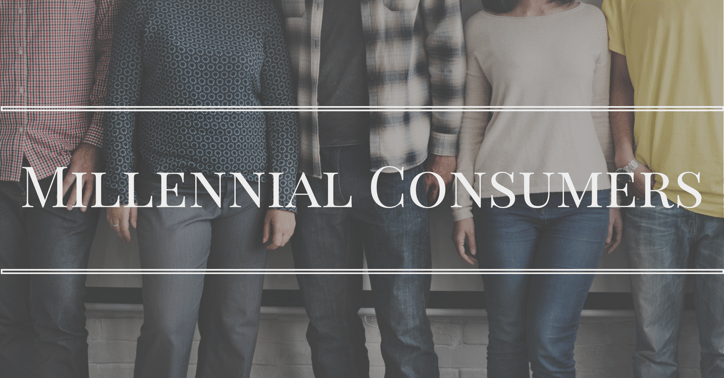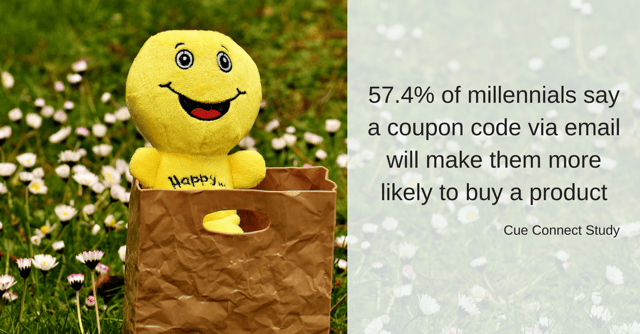Companies have exhausted the “marketing to millennials” efforts. By trying to create an end-all be all marketing solution they’ve alienated an entire generation by making hasty generalizations that are, simply put, inaccurate. Publically labelling them as a millennial is most likely why they're not having too much luck connecting with the largest generation. Somewhat contradictory to what I just said, there’s only one type of millennial consumer: Unique.
While you should avoid categorizing your millennial target market into just a handful of segments, as marketers it’s our job to recognize patterns in consumer behavior. That being said, research from Cue Connect shows a few recognizable patterns that are unique to millennial consumers.

The Social Spender
Stats show that millennials are increasingly aware of what others are buying and how they feel about their purchases. Social media has enabled them to connect with not only their personal networks, but with strangers that have also purchased products they’re interested in.
In fact, 51% of millennials say consumer opinions found on a website have a greater impact on purchasing decisions than recommendations from their family and friends. Regardless of whether they’re shopping online or in-store, these shoppers must get approval, or justification from their peers before making a purchase.
So how do you keep them engaged and tailor the experience to the social spender? BigCommerce recently posted an infographic that notes 4 out of 5 people say posts from friends directly influence their buying decision, so adding viral (shareable) elements to your content is essential to maximizing your reach to millennial consumers.
Include social sharing buttons on your product or services page. Create engaging social content across your social media accounts and enable them to send the picture or content to their friends. This will provide them with the easy opportunity to get the social proof they need to buy your product.
The Bargain Hunter
Instead of digging through those annoying direct mail coupon flyers and snagging coupon cards from local stores, millennials are redefining coupons. Instead, they’ll go to a search engine and search “company name coupon codes”. Everything is going digital, and finding savings has never been easier.
While some will go through an extensive search process for these codes, millennial customers have grown up with the internet and know how to shop smarter. Many of these shoppers expect companies to understand that they’re looking for the best deal possible.

Include a “Wishlist” tool on your website. Not only will this qualify them as a potential customer, but you can also keep them engaged by sending them relevant information. More than 57% of millennials say that an email with a coupon code will make them more likely to buy a product. Using the wishlist tool will allow you to automatically send these emails and drive qualified, intent-driven traffic to your site.
Another way these millennial shoppers are staying ahead of the spending curve is by using technology such as the Google Chrome extension Honey. This software integrates right into the browsing experience by recognizing ecommerce checkout pages. It then gathers coupon codes that have recently been used by other shoppers, and provides them with the discount code, the amount of the discount, and the last time it worked on the site.
Keep a back log of coupons that you might not promote, but don’t expire. For instance, many shoppers will abandon their cart when they see a high shipping price. One way to avoid this from happening is to allow Honey to pull in “Free Shipping” codes and allow bargain hunters to continue through with their purchase.
The Prestige Purchaser
While this type of millennial consumer can sometimes be recognized as a social spender, they’re usually the trendsetter of the pack. These shoppers actively hunt for exclusive offerings such as invite-only events, personalized coupon codes, and unreleased products or beta stage services. Bridging the digital gap with these customers is often a struggle for companies, as it requires a much more personalized experience.
To overcome this issue, let’s look at how these millennials shop. They have the tendency to make impulse decisions, without worrying about the cost. If it’s the new thing, it looks good, and maintains their “luxury” or “trendsetter” status, they’ll click through the purchase without hesitation. These customers are some of the most brand loyal customers you can have the privilege of earning, and making them feel valued is essential to keeping them coming back.
.png?width=625&name=More%2057.4%20of%20millennials%20say%20a%20coupon%20code%20via%20email%20will%20make%20them%20more%20likely%20to%20buy%20a%20product%20(1).png)
They expect special treatment for their loyalty. More than 47% of premier purchasers say that being rewarded with loyalty points after a purchase makes them feel the most valued. Another valuable insight is that 1/3 of these customers wish companies kept track of their favorite brands and sales. They know your company inside and out, and they expect you to do the same for them.
They say that 80% of your sales come from 20% of your customers. Its essential that you focus on retaining these customers. If they don’t feel valued, they’ll simply go to your competitors, tell them you didn’t value them, and they’ll get that relationship from them.
Do whatever it takes to tailor your digital experience to their personal profiles. Send dynamic emails with relevant sales, updates, and events. Switch up the design of your messages so you can make them feel like you’re personally creating a more exclusive experience. Anything that continually builds upon their established loyalty is essential for these customers.
The Impulse Buyer
We’ve all been guilty of going to the store for one thing, and all of the sudden you’re checking out with a full cart. Whether it’s online or in-store, making it easy to add items to the cart and reducing “friction” between arrival and checkout is essential to increasing average sale size.
Amazon is a prime example of this (pun intended). Not only do they allow you to save your preferences, your credit card information, shipping addresses, and past purchases, but they enable impulse buyers to easily make purchases with “1-Click Checkout”. They then use this information to show related products to users across the various stages of their shopping experience. The impulse buyer will see the value these products will add to the main thing they’re buying, and have no problem adding them to the cart as well.
So why do impulse buyers shop like this? It’s simple. FOMO. Well, kind of. In this sense, these types of consumers always want to be prepared. They want to avoid the “Ugh if only I had this to go along with what I bought” feeling. They don’t want to make a second trip back to the store or wait another week for their item to be shipped. It’s about efficiency.
Utilizing a “people also purchased” or a “you might also enjoy” section will allow you to pique these millennials interests’, keep them engaged, and increase their average sale size.
The Shy Shopper
These consumers are quite the opposite of the impulse buyers. They only shop when they need to and usually don’t respond as marketers would like, as they’re not avid spenders. What separates these shoppers from the bargain hunter is their frequency of purchases as well as their purchasing motivations. Let’s take a deeper look.
A great way to identify these types of millennial consumers is looking at the intervals at which they buy. When we compare this to what they’re buying and the volume at which they buy it, companies can set up a specialized schedule to reinforce and uphold their purchasing schedule.
The shy shopper will undergo extensive research when first purchasing a different product or service as they tend to be recurring customers. However, if they’re displeased with performance or value, they have no problem seeking out alternatives.
In order to try and increase these customers’ sale size, you can use similar tactics to that of the impulse buyer. One thing that you must be aware of is that they’re more price cautious. If you’re going to show them another product, it needs to be relevant. Also, make sure the price is aligned with the added value as the shy shoppers are experts at determining whether or not the cost-benefit ratio is worth it.
Overall
Remember, when you’re trying to win the hearts and wallets of millennials, generalizations are the fastest way to failure. These types of millennial shoppers don’t apply to every single millennial out there, and will not allow you to magically get them to shop on your site over your competitors.
Millennials are unique, as a generation and even more so as individuals. As a millennial writing this, I can tell you that I fall into all 5 of these shopping patterns with different brands. I’m an impulse buyer for some and a shy shopper at others. It’s all about understanding the individual users you attract and interact with. Only when you focus on tailoring your marketing approach on the individual level will you be able to really build the brand loyalty and equity that millennials bring with them.





.jpg)